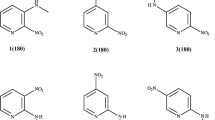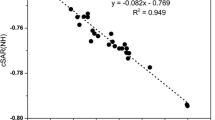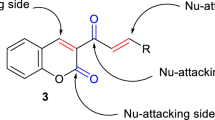Abstract
PF04859989 is a potential novel drug designed to attenuate symptoms of Schizophrenia. We analyzed the substitution effect on PF04859989 using three functional, which included the long-range correction. The substituents were both donor and attractor electrons, in two positions of the fused-ring molecule, in positions six and seven. Global reactivity indices were analyzed, finding that it does not present more information except electrophilicity, when analyzed with respect to the Hammet parameter, representing a quadratic correlation closer to the unit. The hydrophobic capacity (cLogP) was considered, finding that the groups such as \({{\hbox {CH}}_3}\), CN, Cl and COCH3 increase hydrophobic capacity both in substitution in position six and seven. Additionally, we found that isomers conformations in position three of the amino group marked that equatorial isomers are more stable than the axial ones.







Similar content being viewed by others
References
Breshanan M, Menenzes P, Varma V (2003) In: Murray RM, Jones PB, Susser E (eds) The epidemiology of schizophrenia. Cambridge University Press, Cambridge
McGrath JJ (2005) Myths and plain truths about schizophrenia epidemiology—the NAPE lecture 2004. Acta Psychiatr Scand 111:4–11
Hafner H, An der Heiden W (2003) In: Hirsch SR, Weinberger DR (eds) Schizophrenia. Blackwell Science, Oxford, pp 101–141
Andreasen NC, Carpenter WTJ, Kane JM (2005) Remission in schizophrenia: proposed criteria and rationale for consensus. Am J Psychiatry 162:441–449
Allebeck P (1989) Schizophrenia: a life-shortening disease. Schizophr Bull 15:81–89
Brown S (1997) Excess mortality of schizophrenia: a meta-analysis. Br J Psychiatry 171:502–508
Simpson JC, Tsuang MT (1996) Mortality among patients with schizophrenia. Schizophr Bull 22:485–499
Harris EC, Barraclough B (1998) Excess mortality of mental disorder. Br J Psychiatry 173:11–53
Palmer BA, Pankratz VS, Bostwick JM (2005) The lifetime risk of suicide in schizophrenia—a reexamination. Arch Gen Psychiatry 62:247–253
Rajesh R, Tampi R (2018) Schizophrenia: ensuring an accurate Dx, optimizing treatment. J Fam Pract 67:82–87
Hui CW, St-Pierre A, El Hajj H, Remy Y, Hebert SS, Luheshi GN, Srivastava LK, Tremblay ME (2018) Prenatal immune challenge in mice leads to partly sex-dependent behavioral, microglial, and molecular abnormalities associated with schizophrenia. Front Mol Neurosci 11:14
Duncan LE, Ratanatharathorn A, Aiello AE, Almli LM, Amstadter AB, Ashley-Koch AE, Baker DG, Beckham JC, Bierut LJ, Bisson J, Bradley B, Chen CY, Dalvie S, Farrer LA, Galea S, Garrett ME, Gelernter JE, Guffanti G, Hauser MA, Johnson EO, Kessler RC, Kimbrel NA, King A, Koen N, Kranzler HR, Logue MW, Maihofer AX, Martin AR, Miller MW, Morey RA, Nugent NR, Rice JP, Ripke S, Roberts AL, Saccone NL, Smoller JW, Stein DJ, Stein MB, Sumner JA, Uddin M, Ursano RJ, Wildman DE, Yehuda R, Zhao H, Daly MJ, Liberzon I, Ressler KJ, Nievergelt CM, Koenen KC (2018) Largest GWAS of PTSD (N = 20070) yields genetic overlap with schizophrenia and sex differences in heritability. Mol Psychiatry 23:666–673
Drazanova E, Ruda-Kucerova J, Kratka L, Horska K, Demlova R, Starcuk Z, Kasparek T (2018) Poly(I:C) model of schizophrenia in rats induces sex-dependent functional brain changes detected by MRI that are not reversed by aripiprazole treatment. Brain Res Bull 137:146–155
Baratta A, Buchla A, Buck S, Pocivavsek A (2017) Sexually dimorphic response in corticosterone and brain kynurenic acid after acute sleep deprivation in rats. Neuropsychopharmacology 43:S441–S441
Pocivaysek A, Baratta AM, Buchla AD, Thomas MAR (2016) Sexually dimorphic increase in brain kynurenic acid after sleep deprivation. J Womens Health 25:969–970
McGrath J, Saha S, Welham J, El Saadi O, MacCauley C, Chant D (2004) A systematic review of the incidence of schizophrenia: the distribution of rates and the influence of sex, urbanicity, migrant status and methodology. BMC Med 2:13–22
Aleman A, Kahn RS, Selten JP (2003) Sex differences in the risk of schizophrenia: evidence from meta-analysis. Arch Gen Psychiatry 60:565–571
Engin AB, Engin ED, Karakus R, Aral A, Gulbahar O, Engin A (2017) N-Methyl-d aspartate receptor-mediated effect on glucose transporter-3 levels of high glucose exposed-SH-SY5Y dopaminergic neurons. Food Chem Toxicol 109:465–471
Erhardt S, Engberg G (2002) Increased phasic activity of dopaminergic neurones in the rat ventral tegmental area following pharmacologically elevated levels of endogenous kynurenic acid. Acta Physiol Scand 175:45–53
Legault M, Rompre PP, Wise RA (2000) Chemical stimulation of the ventral hippocampus elevates nucleus accumbens dopamine by activating dopaminergic neurons of the ventral tegmental area. J Neurosci 20:1635–1642
Meyer-Lindenberg A, Miletich RS, Kohn PD, Esposito G, Carson RE, Quarantelli M, Weinberger DR, Berman KF (2002) Reduced prefrontal activity predicts exaggerated striatal dopaminergic function in schizophrenia. Nat Neurosci 5:267–271
Hlavacova N, Li Y, Pehrson A, Sanchez C, Bermudez I, Csanova A, Jezova D, Franklin M (2018) Effects of vortioxetine on biomarkers associated with glutamatergic activity in an SSRI insensitive model of depression in female rats. Prog Neuro-Psychopharmacol Biol Psychiatry 82:332–338
Wang W, Zou Z, Tan X, Zhang RW, Ren CZ, Yao XY, Li CB, Wang WZ, Shi XY (2017) Enhancement in tonically active glutamatergic inputs to the rostral ventrolateral medulla contributes to neuropathic pain-induced high blood pressure. Neural Plast 2017. https://doi.org/10.1155/2017/4174010
Sabetghadam A, Korim WS, Verberne AJM (2017) Perifornical hypothalamic pathway to the adrenal gland: role for glutamatergic transmission in the glucose counter-regulatory response. Auton Neurosci Basic Clin 203:67–73
Langner E, Lemieszek MK, Kwiecien JM, Rajtar G, Rzeski W, Turski WA (2017) Kynurenic acid induces impairment of oligodendrocyte viability: on the role of glutamatergic mechanisms. Neurochem Res 42:838–845
Alekseeva EV (2017) Reduced glutamatergic neurotransmission as possible indicator of unfavorable prognosis. Int J Biomed 7:15–23
Boychuk CR, Smith BN (2016) Glutamatergic drive facilitates synaptic inhibition of dorsal vagal motor neurons after experimentally induced diabetes in mice. J Neurophysiol 116:1498–1506
Banerjee AK, Vera WJ (2017) Synthesis of new substituted kynurenic acids. Organ Prep Proced Int 49:53–58
Baran H, Kepplinger B (2009) Cerebrolysin lowers kynurenic acid formation—an in vitro study. Eur Neuropsychopharmacol 19:161–168
Bellocchi D, Macchiarulo A, Carotti A, Pellicciari R (2009) Quantum mechanics/molecular mechanics (QM/MM) modeling of the irreversible transamination of L-kynurenine to kynurenic acid: the round dance of kynurenine aminotransferase II. Biochim Biophys Acta Proteins Proteom 1794:1802–1812
DiNatale BC, Murray IA, Schroeder JC, Flaveny CA, Lahoti TS, Laurenzana EM, Omiecinski CJ, Perdew GH (2010) Kynurenic acid is a potent endogenous aryl hydrocarbon receptor ligand that synergistically induces interleukin-6 in the presence of inflammatory signaling. Toxicol Sci 115:89–97
Secci ME, Auber A, Panlilio LV, Redhi GH, Thorndike EB, Schindler CW, Schwarcz R, Goldberg SR, Justinova Z (2017) Attenuating nicotine reinforcement and relapse by enhancing endogenous brain levels of kynurenic acid in rats and squirrel monkeys. Neuropsychopharmacology 42:1619–1629
Radonjic N, Bagasrawala I, Zecevic N (2017) Increased levels of kynurenic acid affect human developing brain. Biol Psychiatry 81:S295–S295
Martimiano PHD, Oliveira ADB, Ferchaud-Roucher V, Croyal M, Aguesse A, Grit I, Ouguerram K, de Souza SL, Kaeffer B, Bolanos-Jimenez F (2017) Maternal protein-restriction during gestation and lactation in the rat results in increased brain levels of kynurenine and kynurenic acid in their adult offspring. J Neurochem 140:68–81
Zakrocka I, Targowska-Duda KM, Wnorowski A, Kocki T, Jozwiak K, Turski WA (2017) Angiotensin II type 1 receptor blockers inhibit KAT II activity in the brain—its possible clinical applications. Neurotox Res 32:639–648
Notarangelo FM, Schwarcz R (2016) Restraint stress during pregnancy rapidly raises kynurenic acid levels in mouse placenta and fetal brain. Dev Neurosci 38:458–468
Kozak R, Campbell BM, Strick CA, Horner W, Hoffmann WE, Kiss T, Chapin DS, McGinnis D, Abbott AL, Roberts BM, Fonseca K, Guanowsky V, Young DA, Seymour PA, Dounay A, Hajos M, Williams GV, Castner SA (2014) Reduction of brain kynurenic acid improves cognitive function. J Neurosci 34:10592–10602
Greco R, Demartini C, Zanaboni AM, Redavide E, Pampalone S, Toldi J, Fulop F, Blandini F, Nappi G, Sandrini G, Vecsei L, Tassorelli C (2017) Effects of kynurenic acid analogue 1 (KYNA-A1) in nitroglycerin-induced hyperalgesia: targets and anti-migraine mechanisms. Cephalalgia 37:1272–1284
Lukacs M, Warfvinge K, Tajti J, Fulop F, Toldi J, Vecsei L, Edvinsson L (2017) Topical dura mater application of CFA induces enhanced expression of c-fos and glutamate in rat trigeminal nucleus caudalis: attenuated by KYNA derivate (SZR72). J Headache Pain 18:8
Kim IS, Hwang JH, Hirano M, Iwata H, Kim EY (2016) In vitro and in silico evaluation of transactivation potencies of avian AHR1 and AHR2 by endogenous ligands: implications for the physiological role of avian AHR2. Comp Biochem Physiol C Toxicol Pharmacol 187:1–9
Bortz DM, Wu HQ, Schwarcz R, Bruno JP (2017) Oral administration of a specific kynurenic acid synthesis (KAT II) inhibitor attenuates evoked glutamate release in rat prefrontal cortex. Neuropharmacology 121:69–78
Cherian AK, Gritton H, Johnson DE, Young D, Kozak R, Sarter M (2014) A systemically-available kynurenine aminotransferase II (KAT II) inhibitor restores nicotine-evoked glutamatergic activity in the cortex of rats. Neuropharmacology 82:41–48
Dounay AB, Anderson M, Bechle BM, Evrard E, Gan XM, Kim JY, McAllister LA, Pandit J, Rong SB, Salafia MA, Tuttle JB, Zawadzke LE, Verhoest PR (2013) PF-04859989 as a template for structure-based drug design: identification of new pyrazole series of irreversible KAT II inhibitors with improved lipophilic efficiency. Bioorg Med Chem Lett 23:1961–1966
Henderson JL, Sawant-Basak A, Tuttle JB, Dounay AB, McAllister LA, Pandit J, Rong SB, Hou XJ, Bechle BM, Kim JY, Parikh V, Ghosh S, Evrard E, Zawadzke LE, Salafia MA, Rago B, Obach RS, Clark A, Fonseca KR, Chang C, Verhoest PR (2013) Discovery of hydroxamate bioisosteres as KAT II inhibitors with improved oral bioavailability and pharmacokinetics. MedChemComm 4:125–129
Pellicciari R, Rizzo RC, Costantino G, Marinozzi M, Amori L, Guidetti P, Wu HQ, Schwarcz R (2006) Modulators of the kynurenine pathway of tryptophan metabolism: synthesis and preliminary biological evaluation of (S)-4-(ethylsulfonyl)benzoylaianine, a potent and selective kynurenine aminotransferase II (KAT II) inhibitor. ChemMedChem 1:528–531
Pellicciari R, Venturoni F, Bellocchi D, Carotti A, Marinozzi M, Macchiarulo A, Amori L, Schwarcz R (2008) Sequence variants in kynurenine aminotransferase II (KAT II) orthologs determine different potencies of the inhibitor S-ESBA. ChemMedChem 3:1199–1202
Yamamoto S, Ooshima Y, Nakata M, Yano T, Nishimura N, Nishigaki R, Satomi Y, Matsumoto H, Matsumoto Y, Takeyama M (2015) Efficient gene-targeting in rat embryonic stem cells by CRISPR/Cas and generation of human kynurenine aminotransferase II (KAT II) knock-in rat. Transgen Res 24:991–1001
Zagorski ZF, Rejdak RA, Zielinska E, Shenk Y, Zarnowski T, Turski W, Zrenner E, Kohler K (2003) Enzymatic activity of kynurenine aminotransferase I (KAT I) and its cellular expression in the chicken retina during ontogeny. Invest Ophthalmol Vis Sci 44:U388–U388
Dounay AB, Anderson M, Bechle BM, Campbell BM, Claffey MM, Evdokimov A, Evrard E, Fonseca KR, Gan X, Ghosh S, Hayward MM, Horner W, Kim J-Y, McAllister LA, Pandit J, Paradis V, Parikh VD, Reese MR, Rong S, Salafia MA, Schuyten K, Strick CA, Tuttle JB, Valentine J, Wang H, Zawadzke LE, Verhoest PR (2012) Discovery of brain-penetrant, irreversible kynurenine aminotransferase II inhibitors for schizophrenia. ACS Med Chem Lett 3:187–192
Nava DP, Guzmán G, Vazquez-Arenas J, Cardoso J, Gomez B, Gonzalez I (2016) An experimental and theoretical correlation to account for the effect of LiPF6 concentration on the ionic conductivity of poly(poly (ethylene glycol) methacrylate). Solid State Ion 290:98–107
Cardoso J, Nava D, GarcíaMorán P, Hernández-Sánchez F, Gomez B, Vazquez-Arenas J, González I (2015) Synthesis, characterization, and theoretical insights of green chitosan derivatives presenting enhanced Li+ ionic conductivity. J Phys Chem C 119:4655–4665
Cao H, Plichta MM, Schafer A, Haddad L, Grimm O, Schneider M, Esslinger C, Kirsch P, Meyer-Lindenberg A, Tost H (2014) Test-retest reliability of fMRI-based graph theoretical properties during working memory, emotion processing, and resting state. Neuroimage 84:888–900
Braun U, Plichta MM, Esslinger C, Sauer C, Haddad L, Grimm O, Mier D, Mohnke S, Heinz A, Erk S, Walter H, Seiferth N, Kirsch P, Meyer-Lindenberg A (2012) Test–retest reliability of resting-state connectivity network characteristics using fMRI and graph theoretical measures. Neuroimage 59:1404–1412
Devlin B, Melhem N, Roeder K (2011) Do common variants play a role in risk for autism? Evidence and theoretical musings. Brain Res 1380:78–84
Dehaene S, Changeux JP (2011) Experimental and theoretical approaches to conscious processing. Neuron 70:200–227
Yanai T, Tew DP, Handy NC (2004) A new hybrid exchange-correlation functional using the Coulomb-attenuating method (CAM-B3LYP). Chem Phys Lett 393:51–57
Vydrov OA, Scuseria GE (2006) Assessment of a long-range corrected hybrid functional. J Chem Phys 125:234109
Vreven T, Frisch MJ, Kudin KN, Schlegel HB, Morokuma K (2006) Geometry optimization with QM/MM methods II: explicit quadratic coupling. Mol Phys 104:701–714
Vydrov OA, Scuseria GE, Perdew JP (2007) Tests of functionals for systems with fractional electron number. J Chem Phys 126:154109
Chai J-D, Head-Gordon M (2008) Long-range corrected hybrid density functionals with damped atom–atom dispersion corrections. Phys Chem Chem Phys 10:6615–6620
Schäfer A, Horn H, Ahlrichs R (1992) Fully optimized contracted Gaussian basis sets for atoms Li to Kr. J Chem Phys 97:2571–2577
Schäfer A, Huber C, Ahlrichs R (1994) Fully optimized contracted Gaussian basis sets of triple zeta valence quality for atoms Li to Kr. J Chem Phys 100:5829–5835
Frisch MJ, Trucks GW, Schlegel HB, Scuseria GE, Robb MA, Cheeseman JR, Scalmani G, Barone V, Petersson GA, Nakatsuji H, Li X, Caricato M, Marenich A, Bloino J, Janesko BG, Gomperts R, Mennucci B, Hratchian HP, Ortiz JV, Izmaylov AF, Sonnenberg JL, Williams-Young D, Ding F, Lipparini F, Egidi F, Goings J, Peng B, Petrone A, Henderson T, Ranasinghe D, Zakrzewski VG, Gao J, Rega N, Zheng G, Liang W, Hada M, Ehara M, Toyota K, Fukuda R, Hasegawa J, Ishida M, Nakajima T, Honda Y, Kitao O, Nakai H, Vreven T, Throssell K, Montgomery JA, Peralta JE, Ogliaro F, Bearpark M, Heyd JJ, Brothers E, Kudin KN, Staroverov VN, Keith T, Kobayashi R, Normand J, Raghavachari K, Rendell A, Burant JC, Iyengar SS, Tomasi J, Cossi M, Millam JM, Klene M, Adamo C, Cammi R, Ochterski JW, Martin RL, Morokuma K, Farkas O, Foresman JB, Fox DJ (2016) Gaussian 09, Revision A.02. Gaussian Inc., Wallingford
Parr RG, Pearson RG (1983) Absolute hardness: companion parameter to absolute electronegativity. J Am Chem Soc 105:7512–7516
Parr RG, Yang W (1989) Density functional theory of atoms and molecules, 1st edn. Oxford University Press, New York
Pauling L (1932) The nature of the chemical bond. IV. The energy of single bonds and the relative electronegativity of atoms. J Am Chem Soc 54:3570–3582
Pauling L, Sherman J (1937) A quantitative discussion of bond orbitals. J Am Chem Soc 59:1450–1456
Pearson RG (1963) Hard and soft acids and bases. J Am Chem Soc 85:3533–3539
Pearson RG (1966) Acids and bases. Science 151:172–177
Pearson RG, Songstad J (1967) Application of the principle of hard and soft acids and bases to organic chemistry. J Am Chem Soc 89:1827–1836
Pearson RG (1997) Chemical hardness: applications from molecules to solids, 1st edn. Wiley-VCH Verlag GMBH, Weinheim
Parr RG, Szentpály LY, Liu S (1999) Electrophilicity index. J Am Chem Soc 121:1922–1924
Chattaraj PK, Maiti B, Sarkar U (2003) Philicity: a unified treatment of chemical reactivity and selectivity. J Phys Chem A 107:4973–4975
Gázquez JL, Cedillo A, Vela A (2007) Electrodonating and electroaccepting powers. J Phys Chem A 111:1966–1970
Koopmans T (1934) Uber die Zuordnung von Wellenfunktionen und Eigenwerten zu den Einzelnen Elektronen Eines atoms. Physica 1:104–113
Yang W, Mortier WJ (1986) The use of global and local molecular parameters for the analysis of the gas-phase basicity of amines. J Am Chem Soc 108:5708–5711
Kim T, Park H (2015) Computational prediction of octanol–water partition coefficient based on the extended solvent-contact model. J Mol Graph Model 60:108–117
Cai Z-L, Crossley MJ, Reimers JR, Kobayashi R, Amos RD (2006) Density functional theory for charge transfer: the nature of the N-bands of porphyrins and chlorophylls revealed through CAM-B3LYP, CASPT2, and SAC-CI calculations. J Phys Chem B 110:15624–15632
Pedone A (2013) Role of solvent on charge transfer in 7-aminocoumarin dyes: new hints from TD-CAM-B3LYP and state specific PCM calculations. J Chem Theory Comput 9:4087–4096
Alparone A (2013) Response electric properties of alpha-helix polyglycines: a CAM-B3LYP DFT investigation. Chem Phys Lett 563:88–92
Rostov IV, Amos RD, Kobayashi R, Scalmani G, Frisch MJ (2010) Studies of the ground and excited-state surfaces of the retinal chromophore using CAM-B3LYP. J Phys Chem B 114:5547–5555
Limacher PA, Mikkelsen KV, Luethi HP (2009) On the accurate calculation of polarizabilities and second hyperpolarizabilities of polyacetylene oligomer chains using the CAM-B3LYP density functional. J Chem Phys 130:194114
Kobayashi R, Amos R (2006) The application of CAM-B3LYP to the charge-transfer band problem of the zincbacteriochlorin–bacteriochlorin complex. Chem Phys Let 420:106–109
Dennington R, Keith TA, Millam JM (2011) GaussView version 5. Semichem Inc., Shawnee Mission KS
Hammett LP (1937) The effect of structure upon the reactions of organic compounds. Benzene derivatives. J Am Chem Soc 59:96–103
Acknowledgements
The authors thank CONCYTEC for the financial support provided through Project 140-2015-FONDECYT.
Author information
Authors and Affiliations
Corresponding author
Additional information
Publisher's Note
Springer Nature remains neutral with regard to jurisdictional claims in published maps and institutional affiliations.
Published as part of the special collection of articles “CHITEL 2017—Paris—France”.
Rights and permissions
About this article
Cite this article
Lira, J., Valencia, D., Barazorda, H. et al. Effect of substituents on 3(S)-amino-1-hydroxy-3,4-dihydroquinolin-2(1H)-one: a DFT study. Theor Chem Acc 138, 20 (2019). https://doi.org/10.1007/s00214-018-2403-0
Received:
Accepted:
Published:
DOI: https://doi.org/10.1007/s00214-018-2403-0




